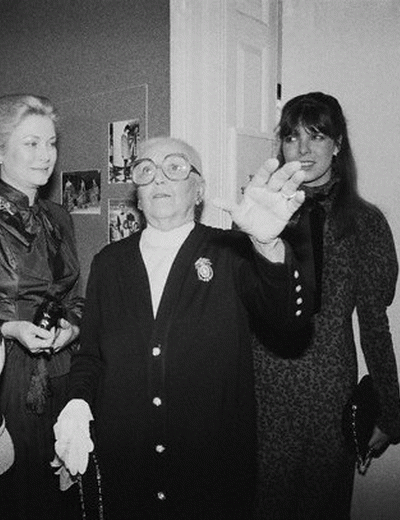
Vera Maxwell
About
the designers
Vera Maxwell was born Vera Huppe in 1901. Her parents were Austrian. She trained as a ballet dancer, joining the Metropolitan Opera Ballet in 1919.
In 1924, Vera married Raymond J. Maxwell with whom she had a son, John who is now a Manhattan physician.
She then worked as a model for a wholesale company and in 1929 started to sketch, design and model her own clothes. Influenced by European childhood tours and a brief period in London studying tailoring, she produced classic styles made of the finest fabrics, silks, tweeds and wools. She lifted her ensembles from her professor-brother's weekend garb and gradually began making clothes for other people. 1936 Vera's clothes were being reviewed admiringly in the fashion press and her free-lance collections received attention in New York. She
She divorced Raymond Maxwell in 1937 and married Carlisle Johnson, an architect, in 1938. They were divorced in 1945.
By designed a weekend wardrobe in 1935 and a collarless tweed "Einstein" jacket in 1936, two of many innovative dressing ideas. She designed for 7th Avenue firms such as Adler and Adler, Glenhunt and Max Milstein.
In 1947 Maxwell opened her own business. Her 1974 "speedsuit" made of jersey with an elasticized waist, can be pulled on in just 17 seconds. She closed her business in 1985 when she was 84 years old and died on 15th January 1995 at the age of 94. She had spent several years writing her memoirs, but these have yet to be published.
The Look
She became known for classic separates and suits, dresses teamed with jackets, print dresses, Chesterfield coats and Wraparound jersey dresses. She used fabrics with character, borrowed either from men's clothes or from day-to-day clothes of different countries, rough hand-woven Indian silks, camel's hair, Austrian loden cloth etc. She was admired for her skill in transforming these heavy fabrics into reed-slim silhouettes. The Maxwell palette was muted, beiges and browns, autumnal reds, ochre’s, olive as well as dark green, and grayed blues. Her practical sense was evident in the clothes she made during the war years. She designed one-piece overalls for female factory workers and overcame the problems of fabric rationing. Her simple lapel-less suits were marvellously spare, and gave no hint of having been stripped of their decorations. Her clothes are timeless, many of the garments she designed in the 50's and 60's display the same simplicity as her wartime designs. She designed for women of short height, or without a model's figure and for women whose jobs take them beyond their desks, she designed season less and uncrushable clothes.